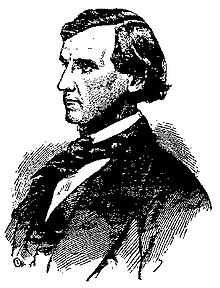John M. Horner
| John M. Horner | |
|---|---|
 | |
| Born |
John Meirs Horner June 15, 1821 Monmouth, New Jersey |
| Died |
May 14, 1907 Kukaiau, Kamakua, Hawaii |
| Occupation | Farmer |
| Spouse(s) | Elizabeth Imlay |
| Children | Robert Horner, William Horner |
| Parent(s) | Stacy Horner, Sarah Johnson |
John Meirs Horner (1821–1907) was a key figure in the early history of San Francisco and southern Alameda County, California especially what is now Fremont, California and Union City.[1]
Biography
Early life
John Meirs Horner was born in June 15, 1821 in Monmouth, New Jersey to Stacy and Sarah Horner (née Johnson). He was a member of The Church of Jesus Christ of Latter-day Saints and first arrived in California on the ship Brooklyn in a group led by Sam Brannan in 1846 with a Mormon group.[1]
Career
He had been a teacher and farmer in New Jersey and quickly took up farming in California quickly became one of California’s premier agriculturists, despite being swindled into buying the same land four times and then losing much of it to squatters (according to his own account).[1]
In 1847, he began farming in the vicinity of Mission San Jose. Although he briefly tried mining in 1848, he realized that there was more potential in farming. By 1849, he was making a profit at selling his produce. He was also connected with early agricultural fairs in California designed to encourage others to be involved in growing produce.
He built a building to be used as a school and meetinghouse. Although he allowed Methodists and Presbyterians to hold meetings there, the main meetings conducted there at which he presided were of The Church of Jesus Christ of Latter-day Saints. This building has been called the first LDS meetinghouse in California.[2]
In 1854, Horner purchased a portion of the Rancho San Miguel, in what is called the western Mission District of San Francisco and parts of Noe Valley.[1][3] By the 1860s Homestead associations were popular in San Francisco as a way for persons of modest means to pool their money and purchase large tracts of land to be subdivided, and for early speculators to acquire groups of lots and even entire blocks for later development.[1] Horner platted his lands (in what is now the Mission District) as blocks and lots, named his new streets based on personal and religious influences, and advertised residential property for sale in Horner's Addition.[1] However very few of his lots sold, due to the hilly terrain, poor access, and economic downturns. Horner lost his entire fortune in the panic of 1857 and was forced to liquidate his land holdings.[1]
Death
He died in May 14, 1907 at age 91 in Kukaiau, Hamakua, Hawaii where he had managed the Kukaiau Plantation Company starting in 1884.[4][5][6]
Legacy
Today, there is a junior high school in Fremont, California named for Horner.
See also
- The Church of Jesus Christ of Latter-day Saints in California
- The Church of Jesus Christ of Latter-day Saints in Hawaii
References
- ↑ 1.0 1.1 1.2 1.3 1.4 1.5 1.6 "Historic Resource Survey Findings, South Mission Historic Resources Survey". United States Department of the Interior, National Park Service. October 2010. Retrieved October 11, 2014.
- ↑ Cowan and Homer. California Saints. p. 146
- ↑ "John Meirs Horner". San Francisco History, SF genealogy. Retrieved October 11, 2014.
- ↑ "Register of the Hamakua Mill Company, Paauilo, Hawaii, 1882-1959", Hawaiian Sugar Planters' Association Plantation Archives (Hamilton Library: Hawaiian Collection at the University of Hawaii at Manoa Library), retrieved 2014-10-13
|chapter=ignored (help) - ↑ "John Meirs Horner". Anthony Gualco's Alvarado History. Retrieved October 11, 2014.
- ↑ Silver, Mae. "The Farmer with the Golden Plow: John Meirs Horner (1821-1912)". FoundSF. FoundSF. Retrieved October 11, 2014.
- Cowan, Richard O.; Homer, William E. (1996), California Saints: A 150-Year Legacy in the Golden State, Provo, Utah: Religious Studies Center of Brigham Young University, pp. 144–147.
- autobiography of Horner with notes based on other writings 20 or more years after his death